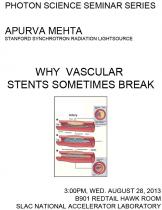Apurva Mehta, SSRL
The phenomenon of superelasticity in near-equiatomic NiTi (Nitinol), which originates from a first order martensitic phase transition, is exploited in an increasing number of biomedical devices, most importantly endovascular stents. Deployment of these superelastic stents, especially in peripheral arteries such as the femoral and carotid, is minimally invasive and is a major advance in treatment of vascular diseases.
A superficial femoral artery (SFA) undergoes ~40 million pulsatile cycles/year as the heart beats and another million complex bending, torsion, and axial distortions as the knee and the hip flexes. Stent manufactures spends large amount of time and money to model the mechanical response of a stent subjected these complex deformations, and design their stents to withstand the computed stresses. But still vascular stents occasionally break in vivo, and these in vivo fractures often occur at unforeseen locations.
In here, I will show that the large variation in the mechanical response of Nitinol arises from a large crystallographic anisotropy in martensitic transformation. The inability of Nitnol deformation models to predict fracture arises from the unfortunate combination of the facts that a) most biomedical devices have a strong crystallographic texture due to manufacturing processes , and b) large crystallographic orientation dependence, which until this work was still very poorly understood, is not included in most continuum based finite-element computational models. A better knowledge of deformation mechanics at atomic scale significantly improves our ability to understand and predict global mechanical response of superelastic Nitinol and directly results in better design strategy for vascular stents.





